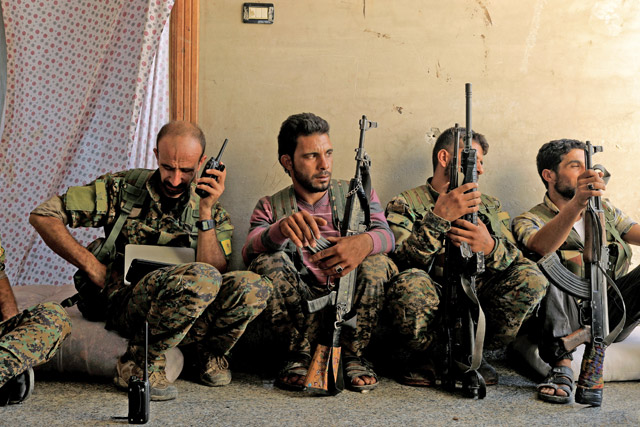RAQQA, Syria — The inexperienced fighters in an Arab group battling to take Raqqa back from Daesh are playing a secondary role to hardened Kurdish militia in the campaign for their home city.
The performance of one lightly trained group seen by Reuters in Raqqa underscored the difficulty of making Arabs the "vanguard" in the battle for the mostly Arab city, as the United States said last year they would be.
In one recent incident, the fighters were quick to open fire after stray bullets flew above their makeshift compound.
"Ceasefire! Can you even see what you're shooting at? Our comrades are somewhere up ahead!" their 27-year-old commander Hassan Khalil shouted to his fighters in the Foj Al Raqqa (Raqqa Regiment).
Meanwhile, Reuters reporters covering the Raqqa assault have watched the Kurdish YPG militia take the most visible role.
It is a sensitive point both for Syrian Arabs and for neighbouring Turkey, which is fighting a Kurdish insurgency in its southeast and has unsuccessfully lobbied Washington to abandon its alliance with the YPG.
Turkey opposes the YPG’s role in the operation, saying it threatens to change the demographics of Raqqa. But in March the new US administration started distributing arms to the YPG ahead of a final assault.
The ragtag, 300-strong Foj Al Raqqa appears to have a more minor role. They are among the myriad militias swelling the ranks of the Syrian Democratic Forces (SDF) alliance, formed in 2015 to fight Daesh.
“We’re proud to be SDF. We hope Arab forces will become as strong as the YPG,” Khalil said at Foj Al Raqqa’s makeshift base near the frontline last week. A live booby-trapped bomb rigged by Daesh militants still lay on their kitchen floor.
A YPG commander at a nearby house said the new recruits were inexperienced but useful. “They’re keen to fight, and they know the area so it’s good for intelligence,” Haval Qahraman said.
SDF spokesman Mostafa Bali said Foj Al Raqqa was made up of men from the city. But in a sign of its subsidiary role, two other senior SDF officials in the alliance’s office in the town of Ain Issa said they had not heard of the group.
Arab fighters hope for a long-term role in Raqqa’s security. But Foj Al Raqqa’s future is uncertain — governance and security arrangements in Raqqa have not been finalised as the fight to capture the city rages.
Another YPG commander said last week that the SDF had surrounded Daesh in central Raqqa, but predicted that the battle could last up to four more months.
In other areas taken by the alliance, such as the town of Manbij, security was handed over to mostly local forces who formed military councils that remained attached to the SDF.
Whether Foj Al Raqqa will receive further training and play that role is unclear. For now, it focuses on the fighting. “Our goal and that of our comrades is the same — finishing off Daesh,” Khalil said.
Native to Raqqa
US coalition forces have trained more than 5,000 Arab fighters since the Raqqa campaign began in November, spokesman Colonel Ryan Dillon said. The current number of Arabs in the SDF is around 24,000 with 31,000 Kurds, he told Reuters.
Foj Al Raqqa wore SDF patches on their clothes. Many others wear the patches of their own militia — often the YPG. A senior US general recently equated the SDF with the YPG, saying the SDF formed after Washington advised the YPG to change its brand.
A YPG commander acknowledged that the Kurdish militia was playing a leading role in Raqqa, but played up the part played by the Arab forces, saying it showed there was no ethnic approach in the operation.
Foj Al Raqqa is new and made up of men native to Raqqa who fled the city during the SDF’s offensive in recent months.
Its fighters were given a crash course in weapons training by the US-led coalition, which also backs the assault on Raqqa with special forces and air strikes.
US training, Soviet weapons
The fighters, many around 20 years old, showed videos on their phones of skirmishes. In one, they tried in vain to shoot down a Daesh drone. Another showed them attacking a sniper position using a rocket-propelled grenade launcher.
Khalil’s second-in-command, Mohammed Hawi, described a 23-day training US forces gave them at a camp in northern Syria after security vetting.
“They taught us how to fire AK47s, Doshka heavy machineguns, BKC light machineguns,” all Soviet-made weapons.
“We learned how to spot booby traps. They filled a room with mock bombs and we’d have to identify them. One mistake and an alarm went off.”
The training has likely saved their lives: they had been able to identify the booby trap in the kitchen — a small white box with electrical wires protruding — as an improvised explosive device (IED).
“[Daesh] had three years to rig Raqqa. It’s full of explosives,” Hawi said.
Khalil’s unit has about 50 fighters, all from districts around Raqqa’s Old City walls.
Each had personal reasons for joining.
Alaa Saeed, a slight 20-year-old, had watched militants behead his cousin when Daesh was at the peak of its rule three years ago.
Despite Daesh’s brutality, the fighters said they would not take revenge in kind.
“If we cut [Daesh] fighters’ throats, we’re no better than them. Better to capture them and let them face justice,” Khalil said.
Asked what they expected the unit’s future to be, the fighters were unsure.
“Of course we want to help run the city and region,” Hawi said.
“Our ambitions right now are to destroy Daesh.”
